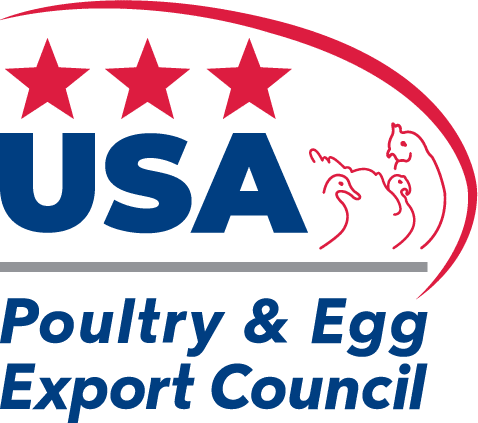Frequently Asked Questions
Here are a few frequently asked questions about the wide range of services that USAPEEC provides. Please feel free to contact us if you have a question that is not answered in the FAQs.
Who are the members of USAPEEC?
As an industry trade association, USAPEEC’s members are made up of those companies that have an interest in increased exports of U.S. poultry and egg food products. Members include poultry and processors, trading companies, and associate members such as cold storage warehousing companies, shipping lines, freight forwarders, and maritime insurance brokers. Also, because increased exports mean increased sales of feed grains, several soybean and corn organizations are members of USAPEEC. At present, USAPEEC has about 200 member companies and organizations.
How do consumers throughout the world know if they are purchasing high-quality poultry products from the U.S.?
All U.S. poultry meat offered for export is inspected and approved by the Food Safety Inspection Service (FSIS) of the U.S. Department of Agriculture (USDA). The USDA is regarded as the highest authority on food inspection in the world. A USDA stamp signifies that a poultry product is of the highest quality and eligible for export.
Can USAPEEC help me resolve an export problem with a foreign government?
It depends on the nature of the problem, but the answer is yes. USAPEEC’s international staff is well connected, both with the U.S. government staff stationed at embassies and Agricultural Trade Offices around the world, and in many cases with local government officials. The home office also has many contacts with the U.S. Department of Agriculture in Washington, D.C. In the majority of cases, USAPEEC can help its members cut through the bureaucracies and solve export problems.
How safe and effective are the U.S. poultry products cold chain?
Frozen chicken and turkey products in bulk are typically frozen together in a carton, and individual pieces can only be removed when the entire carton is defrosted. Bulk frozen chicken products are chilled to approximately 1.7°C to 4.4°C, packed in cartons and placed in a -17.8°C or below. Chicken products are generally bulk-frozen within 24 to 72 hours after slaughter. Individually frozen pieces and individually quick frozen products are also frozen at -17.8°C to -15°C before they are packed in shipping containers and placed in a freezer cooled to -17.8°C or below for storage.
How often are U.S. poultry plants cleaned?
U.S. poultry processing plants are thoroughly cleaned and sanitized for an entire eight-hour shift, every day. All plants are inspected for cleanliness before operations begin and are washed during and after operations.
Why are U.S chickens so big?
U.S. chicken is no doubt the most nutritious and wholesome chicken produced – fed with U.S. corn and soybeans and produced under the strictest government standards and inspection.
U.S. chicken is large due to good breeding, proper nutrition, care by a veterinarian and better living conditions all contribute to the healthier growth of birds.
Is U.S chicken washed in chlorine?
Most U.S. chicken producers promote their products as “NAE”, which stands for “No Antibiotics Ever”.
The National Chicken Council confirms that no chicken sold or raised in the U.S. is given hormones or steroids. In fact, the U.S. Department of Agriculture banned all hormones and steroids in poultry in 1950.
Does poultry contract different diseases that can be harmful to humans if consumed?
Like all fresh foods, poultry carries a natural microflora that may contain organisms potentially harmful to humans. Food safety is a top concern in the U.S. poultry industry, and companies work hard and spend millions of dollars each year to improve the safety of their products. In addition, proper handling, cooking, and storage are essential to maximizing food safety.
What does "hormone-free" chickens and turkeys mean?
All U.S.-produced chickens and turkeys are hormone-free. No artificial or added hormones are allowed by the U.S. government in the production of U.S. poultry. Steroids are similarly banned. Therefore, hormone-free isn’t a necessary label to use, because all U.S. poultry is natural and without hormones.
What is "free-range" chicken?
“Free-range” indicates a production unit where chickens are allowed to forage in an outdoor area in search of insects and other types of “range” food. There is, however, no official federal government definition of “free-range” and the USDA approves label claims on a case-by-case basis.
How humanly are U.S. chicken raised?
No U.S. chicken you buy is raised in a cage. Commercial broiler farms raise chickens in large, well-ventilated, climate-controlled barns where they are protected from the elements, predators, and disease. They have room to move about the house, access food and water 24 hours a day, and interact with other chickens.
Supplier List
USAPEEC is dedicated to serving its members’ needs by offering a list of suppliers and their products.

